Updated: 15-May-2019
Between 1929 and 1945 (end of the war with the US and its allies) Hitachi was constructing medium to low power engines.
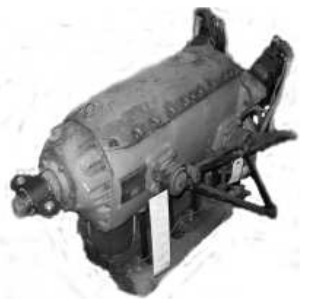
“Hatsukaze 11”
-The Hatsukaze 11 was known as Ha-11 or Model 11. In the factory, it was the GK4 and in the Japanese Navy the Ha47. It was an inverted four-cylinder inline engine that gave 110 CV. It was the Hirth 504 built under license (See Hirth). It had direct output to the propeller.
-There was an interesting version to be used on the piloted flying bomb "Ohka". It was the Tsu-11. See Fuji.
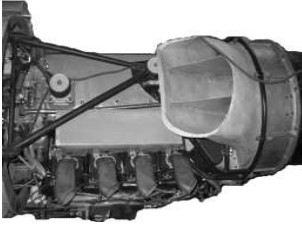
“Hatsukaze-11 on the Tsu-11”
-The piston engine drove a simple fan-compressor to provide a powerful air flow and to burn fuel in a nozzle that would provide a thrust in the manner of the Caproni-Campini motorreactor.
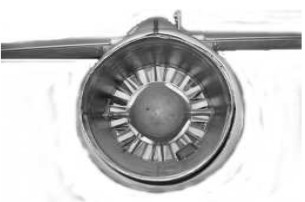
"The fan-compressor from the nozzle"
-The air intake was made on both sides of the "Ohka" as we see in a top view of the power group.
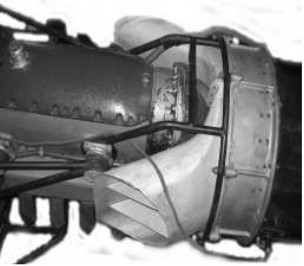
"Attach the motor to the compressor"
-The crankshaft output was not direct but through a gearbox so that while the engine was rotating at 3,000 rpm, the compressor did it at 9,000 rpm.
-The combination weighed 200 Kgs. And the thrust was 180 Kgf.
-The new Tsu-11 combination was officially named Model 13 "Toku" (special) in the Imperial Navy.
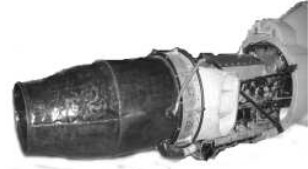
“Tsu-11 combination”
-Here we see the set coupled to the cabin of the "Ohka". Actually the modification was made in the "Naval Technical Arsenal" (sometimes, Naval Arsenal and Naval Air Arsenal. -see Naval T. Arsenal-).
-The photographs of the Tsu-11 have been taken by an AEHS member at the NASM.
-If the Ohka with three solid rocket engines had an autonomy of about 20 km (between glide and the final 9 seconds of rocket operation), with the Tsu-11 (on the Ohka 22) the operation was extended to 80 Kms if It was taken to an altitude of 4,000 meters by a Betty, and about 180 Kms if it was the Ohka 43 with Ne-20 turbojet engine.
-Hitachi's Takahagi plant intervened in the construction of the Ne-230 turbojet engine.
-Previously they had developed the Ne-10 project that was abandoned due to excessive fuel consumption.
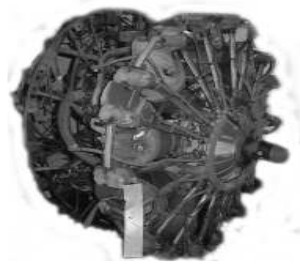
“Amakaze-31”
-In the Hitachi mid-range, from 160 CV to 600 CV, there were 7 and 9 radial cylinder engines.
-The "Kamikaze" (Divine Wind) of 7 cylinders gave 150/160 CV.
-The Hitachi Ha-13, with nine radial cylinders began at 350 CV.
-The Ha-13a with 350 CV was installed on the Ki-9 and the 450 CV version on the Ki-54C from 1941.
-The Ha-42, 7-cylinder radial gave 310 CV.
-The "Tempu" 12, an air-cooled radial of nine cylinders, gave 340 CV and was installed on the Yokosuka E14Y1, in 1941.
-There is information that they made Tempù engines until the model -31, at least.
-The most important, and best known line of Hitachi engines was undoubtedly the "Amakaze". In the factory they were named GK2.
-The most powerful engine was perhaps the GK2C, Amakaze-31, which with its 9 cylinders gave 610 CV (the Koyushu Tokai of 1944 had two engines of these). It is the one of the illustration. Its official specification was Ha-42.
-The Amakaze-21 was the GK4B, with 515 CV.
-In 1934, the 340 CV Amakaze-11 was already mounted on the K5Y1. There was an Amakaze line with the following important models, the -20, -21 or -23.
Note: The Ohka design was made at Japanese Naval Technical Arsenal and then manufactured by various subcontractors.
From Appendix 6: We have received a photo of a Hitachi Hatsukaze 11 (Ha-11) (Hirth License) located on top of a shelf at the NASM warehouse.
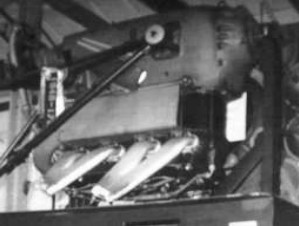
“Hitachi Ha-11”
From Appendix 9: In a Russian publication appears an Ohka 22, more detailed and in which we see the version for launching from the ground by ramp and with rockets.
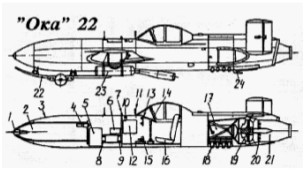
“Ohka 22”
-The Hitachi engine coupled to a compressor and combustion chamber in a motor-jet assembly is already discussed in the main text.
-The two rocket engines attached under the fuselage allowed takeoff from the ground. They were "Tun 4-1".
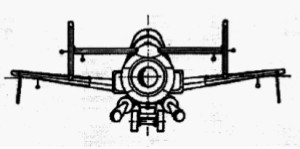
"Ohka 22 on rails and 2 boosters"
Engines of HITACHI
Model: Amakaze GK2 (-GK2B type 21)
Arquitecture:
Cooling:
Total Displacement:
Bore / Stroke: x
Power:
Weight:
Model: GK4
Arquitecture:
Cooling:
Total Displacement:
Bore / Stroke: x
Power:
Weight:
Model: Ha-12
Arquitecture:
Cooling:
Total Displacement:
Bore / Stroke: x
Power:
Weight:
Model: Ha-13, -13a
Arquitecture:
Cooling:
Total Displacement:
Bore / Stroke: x
Power:
Weight:
Model: Ha-42
Arquitecture:
Cooling:
Total Displacement:
Bore / Stroke: x
Power:
Weight:
Model: Ha-47
Arquitecture:
Cooling:
Total Displacement:
Bore / Stroke: x
Power:
Weight:
Model: Hatsukaze-11
Arquitecture:
Cooling:
Total Displacement:
Bore / Stroke: x
Power:
Weight:
Model: Kamikaze
Arquitecture:
Cooling:
Total Displacement:
Bore / Stroke: x
Power:
Weight:
Model: Tempu -11 al -31
Arquitecture:
Cooling:
Total Displacement:
Bore / Stroke: x
Power:
Weight:


